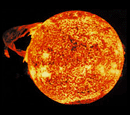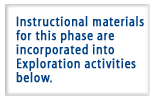




|
 |
 |
  |
|
 |
| This science module focuses on the role of model development
in scientific inquiry and on the technology underlying the
formulation of the Standard Solar Model. If you're using
Genesis science modules for the first time, read the User's
Guide thoroughly before you begin. (View User's Guide
as a PDF.)
The Portable Document Format (PDF) is used to distribute
fully formatted, print-quality documents electronically.
The following information is available to view and
print as a PDF file with Adobe's Acrobat reader. To
install the FREE Adobe Acrobat Reader, visit the Adobe
Web site.
Take a look at other science
modules available. All technical terms in the
science modules are compiled in the Glossary for
easy access.
Technology
Applications are available for this module.
|
|
  |
 |

Which came first, the model or the technology?
The goal of this education module is
to help students understand how the development of
the Standard Solar Model has been limited by available
analytical instrumentation and technology. However,
refinements of the model have played crucial roles
in the design of more advanced instrumentation and
technology, such as will be used in the Genesis project,
which is designed to help scientists determine how
our solar system began and evolved.
During the initial exploration,
students will examine the Standard Solar Model, based
on data from past investigations, using then-current
technology. In the final activity, students will
develop a model that could account for the presence
of heavy elements that are not predicted by the Standard
Solar Model.
Student Mission
Students will explore various aspects of the Standard Solar Model and
gain an appreciation for the interrelationship between what scientists
learned from empirical observation and the development of that model.
|
|
|
|
|
|
Adobe's
Acrobat Reader©

The
Portable Document Format (PDF) is used to distribute
fully formatted, print-quality documents. |
|
Teacher Resources |
| For a listing of additional resources that includes
URLs, books, and periodicals, click
here. |
|
|
|
|
| |
|
|
|
|
|
|
|
|
|
|
|
|
|
 |
|
 |
|
|
 |
During the
Apollo program, a series of solar wind experiments were conducted
on the surface of the moon. For three days, a flag-sized sheet
of aluminum foil collected solar particles. When neon and helium
isotopes were analyzed in the Apollo samples, it was observed
that the ratios of these isotopes were different from those
ratios observed on Earth. This confirmed the need for more
extensive sampling and analysis of the solar wind.
Genesis will continue solar wind experimentation
where Apollo left off. It will obtain the first extraterrestrial
samples since Apollo and bring them back to Earth for analysis.
Plans are being made to analyze these data for the presence
of every element from lithium to uranium, including all the
isotopes along the way. 
Even as the Genesis mission is launched,
researchers will be invited to propose advanced new instrumentation
to study the solar wind samples. When these analyses are
complete, they will be a factor in the interpretation of
a wide variety of space phenomena, resulting in a more thorough
understanding of the composition of the original solar nebula.
It is inevitable that the Genesis data from the solar wind
will result in either improvement in the current model of
the sun's composition or the design of new models.
|
|
 |
Curriculum
Connections
National Standards Addressed
National
Science Education Standards
Grades 9-12
Science as Inquiry |
- Abilities necessary to do scientific inquiry
- Understandings about scientific inquiry
|
| Physical Science |
- Structure of Atoms
- Structure and properties of matter
|
Earth
and Space Science |
- Energy in the Earth System
- The Orgin and Evolution of the Earth System
- The Orgin and Evolution of the Universe
|
Science
and Technology |
- Abilities of Technological Design
- Understandings about Science and Technology
|
| History
and Nature of Science |
- Science as a Human Endeavor
- Nature of Scientific Knowledge
|
|
|
|
|
|
|
|
|
|
|
|
|
In the activities of this module
on the sun and solar wind, the teacher's primary instructional
role is Socratic. Through effective questioning, students should
be made aware of the relationship between what scientists observe
and the models they used to explain that information.
The Student
Activity, "The Invisible Fire," can be used to
introduce students not only to the Standard Solar Model, but also to
some of the history and technology involved in the design of the model.
This awareness will grow as they are involved in modeling the fusion
reaction thought to occur in the core of the sun.
During the activity, students should be guided to an understanding
of the following characteristics of scientific models:
Models corresponding to real events and objects help scientists
understand and explain how things work. These explanations
also generate logic-based models through the incorporation
of new findings.
A good model is based on knowledge-and knowledge is achieved
through scientific inquiry and observation using available
instrumentation. The development of new and better models often
depends upon the development of new and better technological
instrumentation. But the reverse often occurs. |
|
|
|
|
 |
|
|
| |
 |
Use the Student Activity, "Photons
in the Radiative Zone: Which Way is Out?" to create interest
in learning more about the Standard Solar Model. The activity
starts with students simulating photons finding their way out
of a circular maze, which models what we think happens in the
sun's radiative zone.
The activities focused on electromagnetic radiation and solar wind, both
of which affect the Earth and the rest of the solar system, will correlate
the Standard Solar Model with energy and matter leaving the sun.
|
|
|
|
|
|
|
|
|
|
|
Students interact
with peers to accomplish the tasks assigned in the Exploration
and Development sections above. Each activity contains
work to be done in groups, with the whole class  participating
in preliminary and summary discussions. participating
in preliminary and summary discussions.
|

|
|
|
|
|
 |
|
|
| |
 |
Students should be able to use
their direct observations and/or data from other sources to decide
whether or not the Standard Solar Model completely accounts for
observations that do not appear explicitly in the model. If they
decide that the current model is not adequate, they will then
be challenged to supplement the model to include the observations
and/or data presented.
|
|
|
|
|
|
|
|
|
|
|
 The Genesis Outreach Team would like to
extend a special "Thank you!" to Sun and Solar Wind reviewer
and NASA space mission scientist, Dr. Marcia Neugebauer of
the Jet Propulsion Laboratory. From the Apollo missions to
the present, she has pioneered research and investigative work
relating to the study of the solar wind. For more on Dr. Neugebauer's
cutting edge work, read "Pioneers
of Space Physics: A Career In the Solar Wind." The Genesis Outreach Team would like to
extend a special "Thank you!" to Sun and Solar Wind reviewer
and NASA space mission scientist, Dr. Marcia Neugebauer of
the Jet Propulsion Laboratory. From the Apollo missions to
the present, she has pioneered research and investigative work
relating to the study of the solar wind. For more on Dr. Neugebauer's
cutting edge work, read "Pioneers
of Space Physics: A Career In the Solar Wind."
View a personal
interview with Dr. Neugebauer.
|
|
|
|
|
 |
|
|
|
|
 |
|
|
|
|
|
|
| |
|
 |
|
| |
|
|
| Writers: |
WEE3
of Kansas
~ Dr. Donna Bogner
~ Dr. B.J. McCormick
~ Dr. L. Raymond Fox
|
| Graphics: |
~Judy Schlecte, McREL
~Dawn McGill, McREL
|
|
| Special thanks to the following reviewers: |
~Dr. Marcia Neugebauer, Jet Propulsion Laboratory
~Greg Rawls, McREL
~Alice Krueger, McREL
~Jacinta Behne, McREL
|
|
|
|
|
|
|
|
|
|
|
|
|
|
|
|

